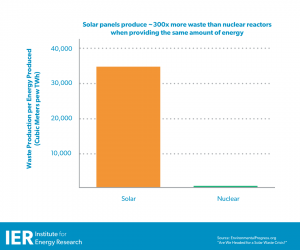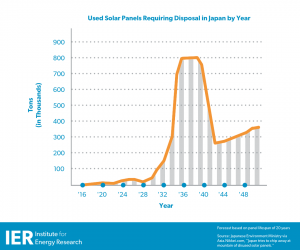Solar panel waste will become a major issue in the coming decades as old solar panels reach the ends of their useful lifespans and require disposal. Last November, Japan’s Environment Ministry issued a warning that the amount of solar panel waste Japan produces each year is likely to increase from 10,000 to 800,000 tons by 2040, and the country has no plan for safely disposing of it.[i] China has more solar power plants than any other country, operating roughly twice as many solar panels as the United States and also has no plan for the disposal of the old panels. In China, there could be 20 million metric tons of solar panel waste, or 2,000 times the weight of the Eiffel Tower, by 2050.[ii] California, another world leader in deploying solar panels, likewise has no plan for disposal, despite its boasts of environmental consciousness. Only Europe requires solar panel manufacturers to collect and dispose of solar waste at the end of their useful lives.[iii]
Environmental Issues with Solar Panels
Solar panels are manufactured using hazardous materials, such as sulfuric acid and phosphine gas, which make them difficult to recycle. They cannot be stored in landfills without protections against contamination. They contain toxic metals like lead, which can damage the nervous system, as well as chromium and cadmium, known carcinogens that can leak out of existing e-waste dumps into drinking water supplies.
A study published last December determined that the net impact of using solar panels actually temporarily increases carbon dioxide emissions, because of the amount of energy needed in the construction process. But, because newer solar panels have a smaller adverse environmental impact than older models and as their time of operation increases to mitigate the construction effects, some scientists believe the solar industry could develop a net positive environmental impact by 2018.[iv]
According to federal data, however, building solar panels significantly increases emissions of nitrogen trifluoride (NF3), which is 17,200 times more potent than carbon dioxide as a greenhouse gas over a 100-year time period.[v] NF3 emissions increased by 1,057 percent over the last 25 years. In comparison, U.S. carbon dioxide emissions only increased by about 5 percent during that time period.
Regardless, the waste disposal issues regarding solar panels are enormous. According to an analysis by Environmental Progress, solar panels create about 300 times more toxic waste per unit of electricity generated than nuclear power plants. For example, if solar and nuclear produce the same amount of electricity over the next 25 years that nuclear produced in 2016, and the wastes are stacked on football fields, the nuclear waste would reach 52 meters (the height of the Leaning Tower of Pisa), while the solar waste would reach 16 kilometers (the height of two Mt. Everests).
Further, while nuclear units can easily operate 50 or 60 years, solar panels have relatively short operational lifespans (20 to 30 years), so their disposal will become a problem in the next few decades. While nuclear waste is contained in heavy drums and regularly monitored, very little has been done to deal with solar waste. Solar waste outside of Europe tends to end up in a large stream of electronic waste.
A report determined that it would take 19 years to recycle all of the solar waste that Japan is expected to produce by 2020. By 2034, the annual waste production will be 70 to 80 times larger than that of 2020. (See graph below.) The projected annual peak of 810,000 tons of solar waste in Japan is equivalent to 40.5 million panels. To dispose of that amount of solar waste in a year would mean getting rid of over 110,000 panels per day.[vi]
Conclusion
Solar photovoltaic energy is not as environmentally conscious a choice as many think it is. Besides being an intermittent source of energy and more expensive than traditional technologies[vii], it has serious waste disposal issues that few countries are tackling. The hazardous materials used in their construction are not easy to recycle and can contaminate drinking water if solely discarded with other electronic waste.
[i] Environmental Progress, Are We Headed For a Solar Waste Crisis?, June 21, 2017, http://www.environmentalprogress.org/big-news/2017/6/21/are-we-headed-for-a-solar-waste-crisis
[ii] Daily Caller, Old Solar Panels Causing An Environmental Crisis In China, August 1, 2017, http://dailycaller.com/2017/08/01/old-solar-panels-causing-an-environmental-crisis-in-china/
[iii] Solar Waste/ European WEEE Directive, http://www.solarwaste.eu/faq/
[iv] Daily Caller, Solar Power Actually Made Global Warming Worse, Says New Study, December 7, 2017, http://dailycaller.com/2016/12/07/solar-power-actually-made-global-warming-worse-says-new-study/
[v] Daily Caller, Solar Panels Increased Emissions Of A Gas 17,200 Times More Potent Than CO2, March 1, 2017, http://dailycaller.com/2017/03/01/solar-panels-increased-emissions-of-a-gas-17200-times-more-potent-than-co2/
[vi] Nikkei Asian Review, Japan tries to chip away at mountain of disused solar panels, November 8, 2016, https://asia.nikkei.com/Tech-Science/Tech/Japan-tries-to-chip-away-at-mountain-of-disused-solar-panels?page=1
[vii] Institute for Energy Research, The Levelized Cost of Electricity from Existing Generation Resources, July 2016, https://www.instituteforenergyresearch.org/wp-content/uploads/2016/07/IER_LCOE_2016-2.pdf





